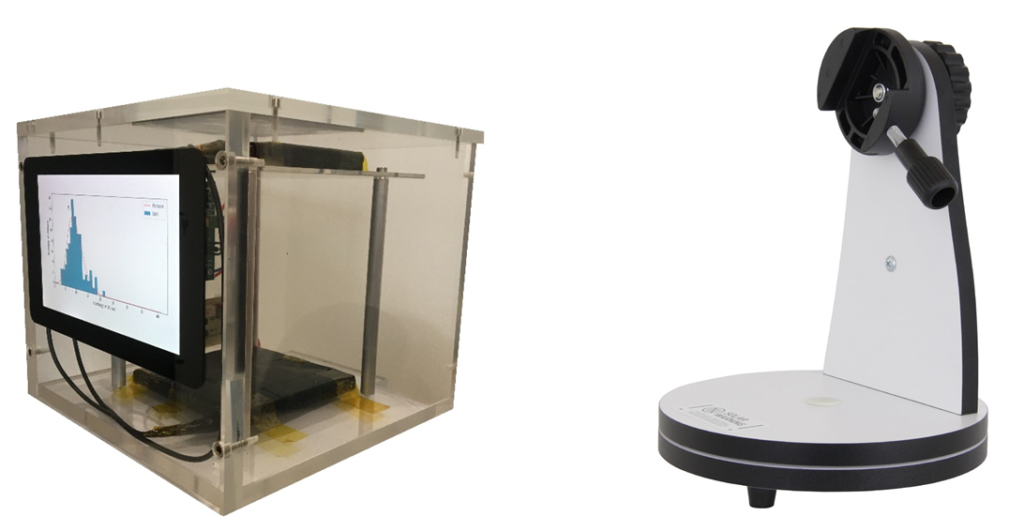Working with cosmic rays at school
Introduction
Cosmic rays are the most amazing natural source of subatomic particles. Protons, alpha particles, other ionized nuclei and electrons, created by the nuclear reactions inside the stars, are emitted with energies that reach the largest ever observed for single particles. After traveling across the universe, they hit the molecules of gas in our atmosphere generating a shower of subatomic particles of different types. Among these are muons, charged particles with properties very similar to the electron, but a mass 200 times larger, which allows them to penetrate many meters of water or even rock, depending on their energy. They reach the surface of the earth at a rate that is about 100 per square meter per second. So they pass through our body continuously, but we can’t perceive them. Our experiment make possible to detect them and measure their flux, allowing for an amazing multidisciplinary journey into modern science. Cosmic rays have been discovered only about 100 years ago, but since then they have been studied extensively and allowed several fundamental discovery, like the first observation of antimatter (the positron i.e. an electron of positive charge). Muons come with either negative or positive electric charge.

A cosmic ray muon counter (CRMC) designed with the classroom in mind
Muons are charged particles that interact in the plastic scintillators used in our detector. Because of their electric charge, they excite or ionise the atomic electrons of the scintillator. Once the excited electrons return to their intial state, a small amount of light is emitted. This light constitutes a signal of the passing muon and needs to be converted to an electric signal for later processing. In our detector we have opted to use the latest technology in photonic sensors to provide carefree and reliable operation. The light signal is converted in an electrical pulse using Silicon Photo Multipliers (SiPM), which are similar to a sensor of a digital camera, but with much greater sensitivity.

Our detector using SiPM and plasti scintillators, can be pointed at different angles to measure the muon flux from different directions. The processed SiPM electrical signals are sent to a Raspberry PI, that time stamps the event. Data acquisition can be switched on/off and monitored using the touch screen on the device or remotely by using the built in ![]() interface.
interface.
Our detector, provides a measurement of the rate R of muons per second for a given direction. This measurement can easily be translated to a measurement of the flux of muons per second per square meter. Furthermore, by rotating the apparatus, for example using our accessory kit, it is possible to measure the flux variation both as a function of the zenith angle or of the east-west direction. In this way the class can verify the effect of the increasing atmosphere thickness traversed by the muons (that causes a decrease in the flux) and of the deflection of primary cosmic rays in the earth’s magnetic field.
Data analysis examples
An in depth explanation of the experiment touches on many different physics aspects. As an example, it is worth noticing that muons, as many other subatomic particles, are unstable and decay in only 2.2 µs (into an electron and two neutrinos). Thus even when moving at nearly the speed of light they could only travel 600 meters or so before decaying. Yet most are created in the upper atmosphere some tens of kilometers high, so how are they able to reach sea level? The answer of course, is due to relativistic time dilation, usually known for the twin paradox. A muon at rest indeed decays on average in 2.2 µs, but when moving at a velocity close to the speed of light it lives much longer for us on earth. The fact that we are able to detect atmospheric muons is a direct consequence of time dilation and therefore a striking evidence of Einstein’s theory of special relativity.

Aside from the many theoretical aspects that can be explained to the students (including the working of the detector itself) there arealso various multidisciplinary aspects that can be shown using appropriate data analysis procedures. For eample one can show that the number of muon events in a fixed time interval ∆t follows a Poisson distribution with mean µ = R∆t and that the time between two consecutive muons follows an exponential distribution f(t) = Re-Rt. Both can be shown with a minimum of mathematical arguments readily available to secondary school students and are a nice example of random variables. From the sequence of time intervals between consecutive muons it is also possible to obtain a true random number generator which can be used as input for a Monte Carlo program.
To help with data analysis, a software suite written in Python is provided for the most common operating systems (Win, Mac, Linux). The students can easily modify the code improving their programming skills and having fun with a real particle physics experiment.
